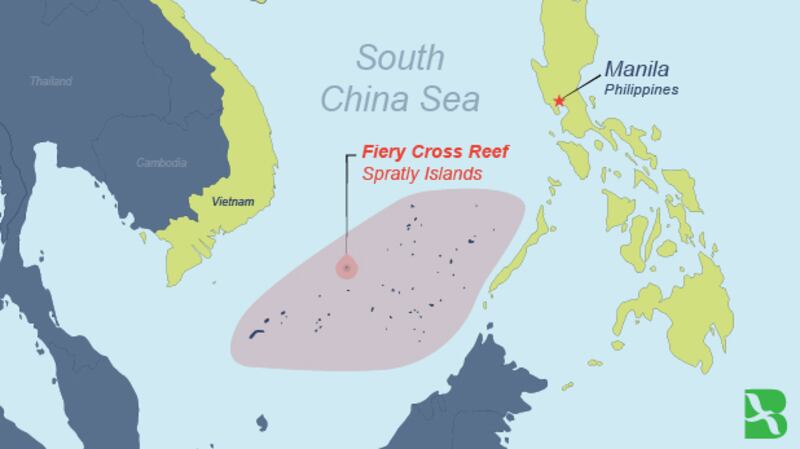Updated at 3:48 p.m. ET on 2019-01-31
The Philippines said Thursday it was verifying reports that China had set up a “maritime rescue center” in the disputed Spratly chain in the South China Sea.
But if the reports proved true, the Philippine government would likely do nothing because the facility at Fiery Cross Reef could help people in distress at sea, presidential spokesman Salvador Panelo said. He also dismissed fears that a Chinese rescue center could affect contending Filipino claims in the waters around the Spratly Islands.
“It’s a distress center, meaning it could help to those who are in need in that region,” Panelo told reporters. “Personally, I don’t think establishing a distress center is bad.”
Still, he said the government would leave it to Foreign Secretary Teodoro Locsin to study the issue and decide whether the Philippines would file a formal protest.
“We will give them the benefit of the doubt,” Panelo said of the Chinese.
“And this is also the country that promised us then that they will allow our fishermen and not stop them from fishing in their territory or what they claimed to be their territory – and they did, they are not disturbing them. So let’s see. Let’s not jump into conclusions,” he added.
Earlier this week, China’s Ministry of Transport opened what it called a “maritime rescue center” on Fiery Cross Reef, according to the state-run Xinhua news service.
The Philippines calls the region Kagitingan Reef, where the Chinese have continued to fortify and expand installations in moves that have defied an agreement with all territorial claimants that there would be no structures built in those areas.
The reef, called Yongshu by the Chinese, lies in the Spratlys, a chain of potentially-rich reefs and atolls claimed by both China and the Philippines. Taiwan, Brunei, Malaysia and Vietnam are also claimants in the sea region, which is known as the West Philippine Sea to Filipinos.

The overlapping claims have long been an irritant in relations between countries in the region. Last year, China agreed to a draft that would eventually serve as a basis for a legally binding code for actions in the sea region.
That code would spell out legal parameters of what each claimant state could do in a bid to avoid the disputes from spiraling out of control. Some countries want the code to be binding and subject to ratification by signatory states.
In 2016, an international arbitration court in The Hague ruled in favor of the Philippines, and threw out China’s expansive claims to the region, which it says it owns almost in its entirety based on historical grounds. Beijing snubbed the ruling, which the international community welcomed as a win for the Philippines.
Philippine President Rodrigo Duterte, however, acted swiftly and moved to appease China by saying he would not seek to impose the ruling. He also changed the country’s foreign policy towards China and Russia, and away from the United States, which has continued to challenge Beijing over the region by mounting freedom of navigation and overflights.
But China recently said that it had installed navigation equipment in its maritime center in Fiery Cross. Filipino intelligence officials said that the reef was also the site of an airbase, with a long runway that could accommodate long aircraft, including bombers.
On Thursday, Supreme Court Justice Antonio Carpio, the most prominent official speaking out against China, said Manila should promptly complain to Beijing about the new facility in the Spratlys. He said the foreign office should quickly file a diplomatic protest over it.
“That’s an exercise of administration and we should contest that because under our law that’s Philippine territory,” Carpio said.
“If a foreign country will say ‘we will use this as a rescue center,’ which they should not do without our approval because that’s ours, so we should protest,” he said.
Inaction would mean that Manila was waiving its rights to the area, he warned.
“We should be wary of that because that’s an exercise of sovereignty or sovereign rights,” Carpio stressed.
